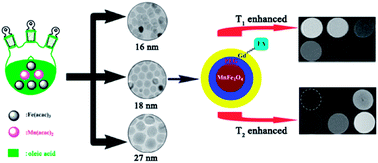Controlled synthesis of MnFe2O4 nanoparticles and Gd complex-based nanocomposites as tunable and enhanced T1/T2-weighted MRI contrast agents†
Abstract
Successful development of magnetic nanoparticles (MNPs) with optimal size, shape, and composition is very desirable because they would increase the image contrast of magnetic resonance imaging (MRI). Here, we report a new precursor-mediated growth process of monodisperse MnFe2O4 NPs with controlled size and shape. MnFe2O4 NPs with plate-like shapes, spherical, and cubic can be successfully prepared by simply tuning the amount of Fe(acac)3 and Mn(acac)2 in oleic acid. Magnetism and MR properties of the particles were found to depend on their size and shape. These MnFe2O4 NPs, when conjugated with gadolinium and folic acid (FA), showed a simultaneous bright signal enhancement on the T1-weighted images and significant signal reduction on the T2-weighted image. In vitro MR imaging experiments also show that the developed multifunctional Gd:FA-DTPA-PEG-DIB-MnFe2O4 NPs enable targeted dual-contrast T1- and T2-weighted MR imaging of tumor cells over-expresses the folate receptor in vitro, and the T1- and T2-weighted MRI has been greatly improved. Our results clearly indicate that such an approach of forming multifunctional Gd:FA-DTPA-PEG-DIB-MnFe2O4 NPs is of great significance for T1- and T2-weighted MR imaging of specific cancer cells with high accuracy.


 Please wait while we load your content...
Please wait while we load your content...